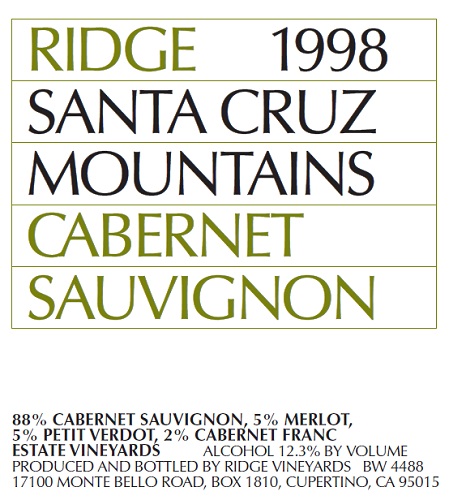
1998 Santa Cruz Mountains Cabernet
Wine Information
88% Cabernet Sauvignon, 5% Merlot, 5% Petit Verdot, 2% Cabernet Franc
Vintage
1998
Vineyard
Monte Bello
Appellation
Santa Cruz Mountains
Alcohol By Volume
12.3%
Vintage Notes
Though this year’s initial crop set was smaller than usual, a very late spring convinced us to reduce it still further by thinning, thus affording the remaining grapes a better chance of full ripeness at harvest. In fact, it was the sunny weather—lasting through mid – November—that made the crucial difference. Each year, Ridge produces two cabernet-based wines from the estate vineyards: Monte Bello, and this more approachable Santa Cruz Mountains. In 1998 the wine came principally from Twenty-five Acre block on the lower vineyard, and Camp Hill, Le Vasseur, Young Foster and Back Hill on the middle. Firm acid and easily extracted tannins allowed us to cut time on the skins, which made a more sensuous wine. As part of an ongoing comparison, half of it completed a natural secondary fermentation in barrel, half in small stainless steel tanks. Extended aging took place in one- and two-year-old american oak barrels. This complex, full-bodied wine resembles a Monte Bello in style. It will soften and develop further with five to ten years in bottle.
History
There are three major plantings of bordeaux varieties on the Monte Bello estate. Between 1300 and 2000 feet of elevation is the “lower” vineyard, where cabernet was first planted in the late nineteenth century. The “middle” (2100′-2400′) includes the fifty-year-old vines from which the first forty-eight bottles of Monte Bello were made in 1959. The third is the “upper” (2500′-2660′), home to a number of thirty-three-year-old plantings and the 116-year-old winery that is the Ridge production facility.
Growing Season
This year, the three were sub-divided into thirty-three smaller parcels—each differing slightly in character and style; these are harvested and fermented separately. In 1998 a very late spring interfered with the grapes’ flowering and set, reducing crop from the outset, and moving the whole growing season back by a month. After a light rain in August, when the grapes were still small, hard, and green, we opened the vines to sun and air. In September, when the color changed (veraison), we thinned heavily—despite the already small crop—in a somewhat desperate attempt to ensure ripeness before the winter rains arrived. Also to that end, we spread reflective foil under the vines. Most frequently used in orchards to help ripen and color the fruit, it had the desired effect in the vineyard. Sunny weather through mid-November ripened all the grapes, but later than ever before.
Winemaking
Fermentations took place without inoculation (natural primary and natural malolactic). As we saw how quickly color and tannin were extracted, we limited pump-overs and time on the skins and seeds. Comparison tastings are done in February following vintage, to assess which lots belong in the Monte Bello, and which in the Santa Cruz Mountains. Softer, more elegant wines go to the latter; those more intense and structured usually go to the former. This year, however, was an exception. Several lots were held out of the Monte Bello as too tannic. These were fined with fresh egg whites to soften the tannins—first in March after vintage, and again a year later. The Santa Cruz Mountains is normally bottled after eighteen months in barrel; but the firm structure of the ’98 required an additional eight months to balance tannin, fruit, and acidity. This excellent wine is approachable now, and recommended to accompany rich, flavorful food. Bright raspberry and hints of cedary oak combine beautifully within a full, round structure. The ’98 Santa Cruz Mountains will be at its best over the next ten years.
Consumer Tasting Notes
Average Rating: 89.5
No. of Tasting Notes: 21
View this wine on CellarTracker
Wait!
In order to qualify for user related discounts, you must log in before proceeding with checkout. Click the button below to log in and receive these benefits, or close the window to continue.
Log In